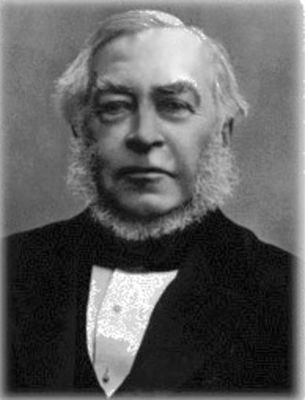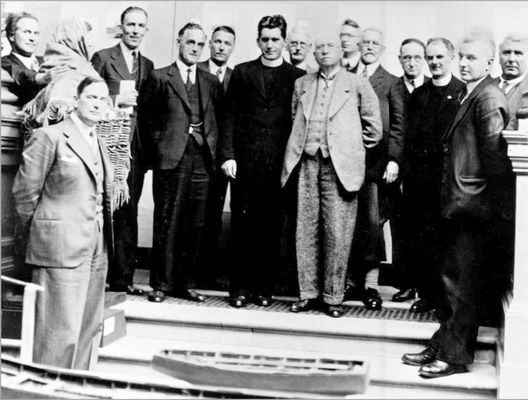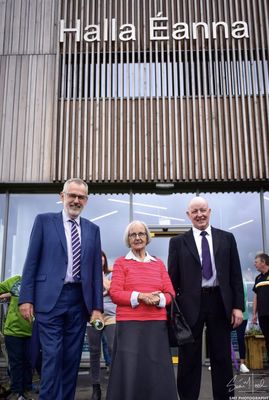MY mother used to tell us that St Brigid’s Day, February 1, was the first day of Spring. I never thought too much about this but I pointed out that there was snow later in the month. I can remember my mother telling me that I should also look out for something else white – snowdrops.
Living in the higher part of lofty Glengormley I’m aware that we are a couple of weeks behind the rest of the country. The lawn mowers are put away earlier and reintroduced later than in most parts of the country.
However, on St Brigid’s Day I was walking along the foreshore near Whiteabbey. I stopped for a breather. For some reason I thought of old Peter McKernon. Many years ago Peter would go to the Bellevue Arms on Monday, pension day. Later he would make his way up the Antrim Road. He would stop and look at the trees in Elmfield. I once said to his son, young Peter, that he had a great interest in nature but he told me he was just out of breath and was in a hurry to get to the Glen Inn for a couple of pints before teatime. Young Peter passed away before Christmas aged 93!
As I looked I couldn't believe my eyes. I detected the smallest buds on a silver birch tree and the same on a nearby small alder tree. And there was more.
What we call whin bushes in Armagh, gorse, are now sprouting as well. It will be the month of May before here, Carnmoney and Cave Hill will be a sea of bright yellow or golden magic but the process has started.
Just then, a Whiteabbey man saw me and stopped. He beckoned me to the shade of a larger clump of trees and pointed down to the ground. There was an unmistakable cluster of what we will shortly recognise as snowdrops. My guide told me to keep an eye on this particular well sheltered spot as we will soon have daffodils and crocuses later followed by bluebells.
Whenever I took early retirement from teaching some twenty five years ago I began to spend time with the craft workers in Brookfield Mill on the Crumlin Road and with Eamonn Maguire in particular. I was truly astounded with Eamon’s talents and in particular with his ability to incorporate his extensive knowledge of Celtic history and mythology into his everyday work.
Eamon has now retired but his work can be found worldwide. The bodhráns he made were distinctive in that they were made from the skins of goats which were hunted and caught by himself. Having made the bodhráns he then decorated them. He would listen to the people who ordered the bodhráns and incorporate their interests in his illustrations which usually had a Celtic theme.
While the bodhrán-making was his main output, Eamon produced oil paintings which were very popular. It seemed to me that whenever he framed his latest effort and put it on display on his workshop wall it disappeared within a week.
However, in my opinion Eamon’s greatest talent was wood carving and once again his work was unique. The majority of his work was completed in bog oak.
Over thousands of years trees fell into wetlands, swamps and fens. They lay submerged and untouched. As oak is rich in tannin, they were preserved while other types of trees simply rotted. The area surrounding Lough Neagh was one of the most prolific sources of bog oak. As the water levels decreased more and more land close to the lake became available to farmers.
As they ploughed the land they encountered the remains of giant oak trees which interfered with their land reclamation. They used tractors to pull the timber pieces from the ground and masses of blackened timber were a common sight in the corners of fields in these lowlands.
These were usually burned in the autumn and the ashes ploughed back into the soil in the spring. Eamon Maguire came to know many of the farmers on the shores of Lough Neagh and they cheerfully stored for him the pieces of bog oak which surfaced on their land. Eamon would arrive and bring back trailer loads to his workshop. He had a store full of bog oak trunks in various stages of drying out.
While most of us saw jagged pieces of blackened timber Eamon would study each piece on a regular basis and saw the potential in each piece.
I often watched him work with hammer and various chisels while he chatted away to all and sundry about the local gossip. Incredibly, we would see various figures emerge from the old tattered log as if Eamon knew they were hiding in there and he was just liberating them. A work of genius. It's tragic that so many figures, always with a Celtic theme, were produced and exported (the majority of his output was bought by Americans) without even being photographed.
One exception was when Father Myles Kavanagh approached Eamon in December 1997 and told him he needed a little piece to present to the newly elected President of Ireland, Mary McAleese, who was making her first trip since her election to Belfast.
Eamon had no hesitation. He retrieved a fairly sizeable log and without reference to diagrams or illustrations he began to carve. As usual he “knew what was in there” and within a week we saw a distinctive outline of what Eamon told was “Dubthach the Dagda” the great God of the Celtic race.
We all nodded when Eamon recalled various feats of the Dagda when he led the forces of the Tuatha Dé Danann in battle where his presence often resulted in victory for his own tribe as if we had known about him and his family all our lives. In fact, everyone was being given a history lesson!
And, of course, it was Eamon who Informed us that Dubthach, then the Dagda, was the father of St Brigid. President McAleese was visibly delighted when presented with the carving. Fr Myles was delighted. Eamon just carried on carving.
There is now a campaign to make St Brigid’s Day a public holiday in Ireland. Ireland has fewer public holidays than most other countries. It would celebrate the coming of a spring, complement St Patrick with equality between masculine and feminine, recognise the stories of Brigid as pagan, Christian, northerner and southerner, commoner and goddess of healing, fire and light, a patron saint and a Matron Saint.
Given that it is halfway between December and March, which has been accentuated in this time of lockdown as the most depressing time of the year, it would make for the perfect festival to herald the beginning of spring – and hope.








